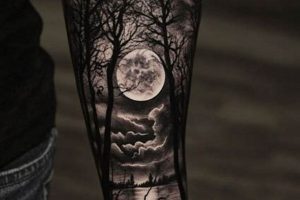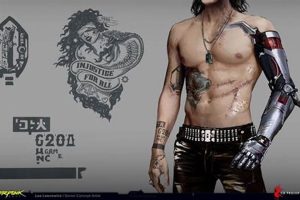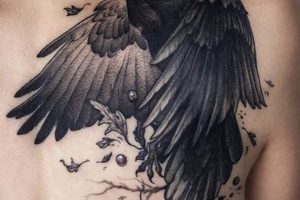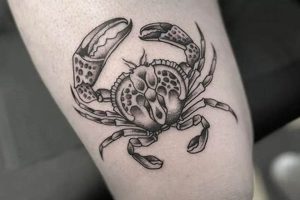Tattoos inspired by Chicano culture often feature imagery drawn from a rich visual vocabulary. Common themes encompass religious iconography (such as Virgin Mary or praying hands), cultural symbols (like sugar skulls or lowriders), family portraits, and stylized lettering representing neighborhoods or loved ones. These designs can incorporate vibrant colors, intricate details, and bold black lines, reflecting the unique aesthetic traditions of the Chicano art movement.
These visual expressions serve as powerful statements of cultural pride, personal history, and community affiliation. Rooted in the Mexican American experience, particularly from the mid-20th century onwards, they act as a visual language expressing resilience, resistance, and remembrance. These tattoos can honor family heritage, commemorate significant life events, or pay tribute to the struggles and triumphs of the Chicano community. The artistry often draws inspiration from historical movements like the Chicano Movement and its associated artistic expressions.
Exploring specific thematic categories, such as religious imagery, cultural symbols, portraiture, and lettering styles, provides a deeper understanding of the rich symbolism and artistic traditions within Chicano tattooing. Further investigation into the historical and social context surrounding these designs offers valuable insight into the cultural significance they hold.
1. Cultural Pride
Cultural pride forms a cornerstone of Chicano tattoo art, serving as a powerful visual declaration of heritage and identity. These tattoos become a tangible expression of a shared history, connecting individuals to a broader community and signifying resilience in the face of social and political challenges. The act of permanently inscribing cultural symbols onto one’s body underscores a deep commitment to preserving and celebrating Chicano traditions. For example, the prominent display of a lowrider, a symbol of Chicano customization and cultural innovation, reflects pride in a unique artistic expression born within the community.
The choice of specific imagery often reflects the individual’s personal narrative within the larger Chicano experience. Family portraits, for instance, can honor ancestral lineages, while depictions of historical figures or movement leaders can commemorate key moments of struggle and activism. The incorporation of indigenous imagery, such as Aztec or Mayan symbols, connects contemporary Chicano identity to its pre-colonial roots, reclaiming a historical narrative often marginalized. Similarly, the use of stylized script, reminiscent of classic Chicano graffiti art, demonstrates pride in a distinct aesthetic tradition born from urban environments.
Understanding the profound connection between cultural pride and Chicano tattoo art provides valuable insight into the social and historical context surrounding these visual expressions. This awareness enriches appreciation for the artistry and symbolism embedded within each design, recognizing them not merely as body decorations, but as powerful statements of identity, resilience, and cultural continuity.
2. Religious Imagery
Religious imagery holds profound significance within Chicano tattoo art, reflecting deep-seated spiritual beliefs and cultural traditions. Often drawing from Catholicism, a dominant faith within Chicano communities, these depictions serve as expressions of devotion, protection, and spiritual guidance. Representations of the Virgin of Guadalupe, a revered figure symbolizing hope and resilience, frequently appear, often adorned with roses and emanating a divine aura. Praying hands, crucifixes, and sacred hearts also feature prominently, embodying faith and reverence. These religious symbols often intertwine with other cultural motifs, creating a complex tapestry of visual narratives.
The incorporation of religious iconography extends beyond mere aesthetic representation, acting as a source of strength and solace. These tattoos can serve as reminders of spiritual values, offering comfort during challenging times and reinforcing a connection to a higher power. They can also function as talismans, believed to offer protection and guidance in daily life. For instance, a tattoo of the Virgin Mary might be seen as a source of maternal protection, while a depiction of St. Jude, the patron saint of lost causes, might offer hope in difficult circumstances. The specific choice of religious imagery often reflects personal beliefs and experiences, creating a deeply individual expression of faith.
Understanding the role of religious imagery within Chicano tattooing provides crucial insight into the spiritual and cultural dimensions of these artistic expressions. These symbols represent not only religious devotion but also cultural identity, resilience, and the enduring influence of faith within Chicano communities. Recognizing the complex interplay between religious belief, cultural heritage, and personal narrative enhances appreciation for the rich symbolism embedded within these powerful visual statements.
3. Family & Community
Family and community represent cornerstones of Chicano culture, profoundly influencing artistic expression within Chicano tattooing. These tattoos serve as powerful declarations of belonging, honoring familial bonds and commemorating shared experiences within the community. They reflect deep-rooted values of loyalty, solidarity, and mutual support, visually narrating personal histories intertwined with collective identity.
- Portraits of Loved Ones
Portraits of family members, often rendered in a realistic or stylized manner, serve as enduring tributes to loved ones. These tattoos commemorate familial bonds, preserving the memory of ancestors, parents, children, or other significant figures. They can also represent chosen family, honoring individuals who provide essential support and kinship.
- Neighborhood Pride
Neighborhoods often function as extended families within Chicano communities, fostering strong ties and shared experiences. Tattoos featuring neighborhood names, street signs, or area codes express deep-seated local pride and affiliation. These designs symbolize a sense of belonging and shared identity, honoring the places that shaped individual and collective narratives.
- Cultural Heritage Symbols
Shared cultural symbols, such as lowriders, calaveras (sugar skulls), or indigenous imagery, can represent broader community connections. These designs transcend individual family histories, signifying a collective heritage and shared cultural identity. They act as visual markers of belonging within the larger Chicano community.
- Memorial Tattoos
Memorial tattoos commemorate lost loved ones, preserving their memory within the community. These designs can incorporate portraits, names, dates, or symbolic imagery representing the individual’s life and legacy. They serve as a lasting tribute and a source of comfort, ensuring that the deceased remain an integral part of the community’s collective memory.
The emphasis on family and community within Chicano tattooing underscores the importance of these social structures within Chicano culture. These visual expressions serve not only as personal adornments but also as powerful statements of belonging, shared history, and collective identity. They reflect the deep-rooted values that bind Chicano communities together, emphasizing the enduring strength of familial bonds and the importance of honoring both individual and collective narratives.
4. Political Statements
Political statements represent a significant dimension within Chicano tattoo art, reflecting a history of social and political activism. These tattoos serve as powerful visual pronouncements, expressing resistance, solidarity, and the ongoing struggle for equality and social justice. They draw inspiration from historical movements, such as the Chicano Movement of the 1960s and 70s, which fought for civil rights, land rights, and improved social conditions for Mexican Americans. These designs can incorporate portraits of key figures like Cesar Chavez, Dolores Huerta, or Emiliano Zapata, symbolizing leadership and resistance. Incorporating slogans like “Viva La Raza” or imagery related to the United Farm Workers reflects ongoing struggles for labor rights and social equality.
The use of political imagery extends beyond historical commemoration, addressing contemporary social and political issues. Tattoos might feature imagery related to immigration rights, police brutality, or environmental justice, reflecting ongoing concerns within Chicano communities. These visual statements serve as calls to action, raising awareness and promoting dialogue around critical issues. For example, a tattoo featuring a caged butterfly might symbolize the plight of undocumented immigrants, while an image of a raised fist might represent solidarity and resistance against systemic oppression. The choice of specific imagery reflects the individual’s political convictions and their commitment to social change.
Understanding the political dimension of Chicano tattooing provides essential context for interpreting these powerful visual expressions. They represent not merely aesthetic choices but acts of resistance, solidarity, and cultural affirmation. Recognizing the historical and social context surrounding these designs deepens appreciation for their significance as powerful statements within ongoing struggles for social justice and equality. These tattoos serve as tangible reminders of the ongoing fight for civil rights and the enduring power of collective action within Chicano communities.
5. Stylized Lettering
Stylized lettering constitutes a crucial element within Chicano tattoo art, significantly contributing to the overall aesthetic and conveying cultural meaning. The distinct lettering styles often employed draw inspiration from various sources, including traditional calligraphy, Chicano graffiti art, and vintage typography. These lettering choices imbue tattoos with a unique visual flair, reflecting cultural pride and artistic expression. The stylized script often accompanies imagery, enhancing the narrative and symbolic depth of the tattoo. For instance, names of loved ones, neighborhoods, or significant dates rendered in elaborate script amplify the personal and cultural significance of these elements.
Specific lettering styles, such as Old English or Gothic fonts, frequently appear in Chicano tattoo designs, often adapted and embellished to create a distinctive Chicano aesthetic. The meticulous execution of these letterforms demonstrates artistic skill and attention to detail, elevating the tattoo beyond mere text to a visual art form. Furthermore, the choice of typeface can convey specific meanings. Bold, assertive scripts might communicate strength and resilience, while more flowing, elegant scripts might express love and devotion. Consider the example of a tattoo featuring the name of a loved one rendered in an elaborate, flowing script adorned with decorative flourishes; this stylistic choice enhances the emotional resonance of the tribute. Similarly, a neighborhood name rendered in a bold, impactful script might represent pride and loyalty to one’s community.
The skillful integration of stylized lettering elevates Chicano tattoo art, adding layers of meaning and visual richness. Understanding the nuances of these lettering choices provides deeper insight into the cultural and artistic significance of Chicano tattooing. From honoring loved ones to expressing cultural pride, stylized lettering plays a crucial role in conveying personal narratives and collective identity within this vibrant art form. The careful selection and execution of lettering contribute significantly to the overall impact and enduring legacy of Chicano tattoos, solidifying their status as powerful expressions of cultural identity and personal meaning.
Tips for Choosing Chicano Tattoo Designs
Careful consideration ensures a meaningful and aesthetically pleasing tattoo that resonates with personal values and cultural heritage. The following tips offer guidance for navigating the design process.
Tip 1: Research Artists Specializing in Chicano Style: Locating experienced artists familiar with the nuances of Chicano tattooing ensures authentic and skillfully executed designs. Examining portfolios helps assess artistic style and technical proficiency.
Tip 2: Reflect on Personal Significance: Selecting imagery that holds personal meaning imbues the tattoo with lasting significance. Consider family history, cultural heritage, and personal values when choosing designs.
Tip 3: Explore Symbolism: Understanding the symbolism associated with various Chicano motifs ensures appropriate and meaningful representation. Researching cultural and historical contexts informs design choices.
Tip 4: Plan Placement and Size: Carefully consider tattoo placement and size, taking into account body contours and desired visibility. Larger, more intricate designs may require larger areas, while smaller, simpler designs offer greater flexibility in placement.
Tip 5: Discuss Design with the Artist: Collaborating with the chosen artist ensures a design that aligns with personal preferences and artistic expertise. Open communication facilitates the creation of a unique and personalized tattoo.
Tip 6: Prioritize Quality Aftercare: Following proper aftercare procedures ensures optimal healing and preserves the vibrancy of the tattoo. Consult with the artist for specific aftercare instructions and adhere to them diligently.
Tip 7: Embrace the Collaborative Process: View the tattooing process as a collaborative journey with the artist. Openly communicate ideas and preferences while respecting the artist’s expertise to create a truly meaningful piece of art.
Considering these factors contributes to a well-informed decision, resulting in a tattoo that holds deep personal and cultural significance. A thoughtfully chosen and expertly executed Chicano tattoo serves as a powerful expression of identity and heritage.
These tips offer a starting point for exploring the rich world of Chicano tattoo art, paving the way for a meaningful and aesthetically compelling tattoo experience.
Frequently Asked Questions about Chicano Tattoos
This section addresses common inquiries regarding Chicano tattoo designs, offering clarity and guidance for those considering such tattoos.
Question 1: What distinguishes Chicano tattoo style from other tattoo styles?
Chicano tattoo style distinguishes itself through its unique blend of cultural symbolism, historical references, and artistic influences. Common themes include religious iconography, family portraits, and cultural symbols like lowriders, often rendered with bold lines, vibrant colors, and intricate details, drawing inspiration from the Chicano art movement and historical context.
Question 2: How does one find a reputable artist specializing in Chicano tattoos?
Locating reputable artists specializing in Chicano tattoos requires thorough research. Seek recommendations from within the Chicano community, explore online portfolios showcasing relevant work, and visit tattoo studios known for Chicano style expertise. Verify the artist’s experience and understanding of Chicano cultural symbolism before making a decision.
Question 3: Are there specific cultural sensitivities to consider when choosing a Chicano tattoo design?
Respect for cultural heritage remains paramount when choosing a Chicano tattoo. Thorough research and understanding of the symbolism behind chosen imagery are essential. Consulting with individuals knowledgeable in Chicano culture ensures respectful representation and avoids misappropriation of culturally significant elements.
Question 4: What is the typical cost range for Chicano tattoos?
The cost of Chicano tattoos varies depending on size, complexity, artist experience, and geographic location. Small, simple designs may cost less than larger, more intricate pieces requiring multiple sessions. Consulting with chosen artists provides accurate cost estimates based on individual design specifications.
Question 5: How does one ensure proper healing and long-term care for a Chicano tattoo?
Proper aftercare is crucial for preserving the integrity and longevity of Chicano tattoos. Following the artist’s specific aftercare instructions diligently is essential. This typically includes keeping the tattoo clean, moisturized, and protected from sun exposure during the healing process, which can take several weeks. Continued care, such as using sunscreen and avoiding harsh chemicals, ensures the tattoo’s vibrancy over time.
Question 6: Can individuals outside the Chicano community get Chicano tattoos?
The decision to get a Chicano tattoo outside the Chicano community requires careful consideration and respect for cultural boundaries. Appropriation versus appreciation remains a crucial distinction. Thoroughly researching the cultural significance of chosen imagery and engaging in respectful dialogue with members of the Chicano community demonstrates cultural sensitivity. Genuine appreciation, rather than superficial adoption of aesthetic elements, should motivate such decisions.
Careful consideration of these frequently asked questions ensures informed decisions and fosters respectful engagement with the rich tradition of Chicano tattoo art. Prioritizing cultural sensitivity, artistic integrity, and responsible decision-making contributes to meaningful and enduring tattoo experiences.
Further exploration of specific design elements and consultations with experienced artists provide additional guidance throughout the process of acquiring a Chicano tattoo.
Chicano Tattoo Ideas
Exploration of designs inspired by Chicano culture reveals a rich tapestry of visual narratives. Themes encompassing religious devotion, familial bonds, cultural pride, and political statements intertwine, reflecting the multifaceted nature of Chicano identity. From stylized lettering to symbolic imagery, these artistic expressions serve as powerful declarations of heritage, resilience, and community connection. Careful consideration of design choices, informed by cultural understanding and collaboration with skilled artists, ensures meaningful and enduring representations of personal and collective narratives.
Chicano tattoo art stands as a testament to the enduring power of cultural expression. These visual statements, etched onto the skin, transcend mere adornment, becoming potent symbols of identity, resistance, and remembrance. Continued exploration of this vibrant art form offers deeper insights into the historical, social, and artistic legacies shaping Chicano communities and their enduring contributions to the broader cultural landscape.







